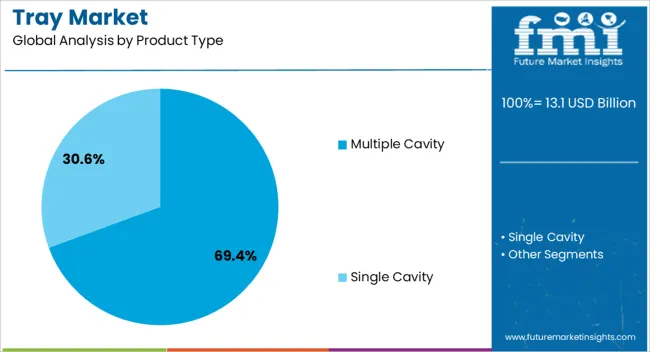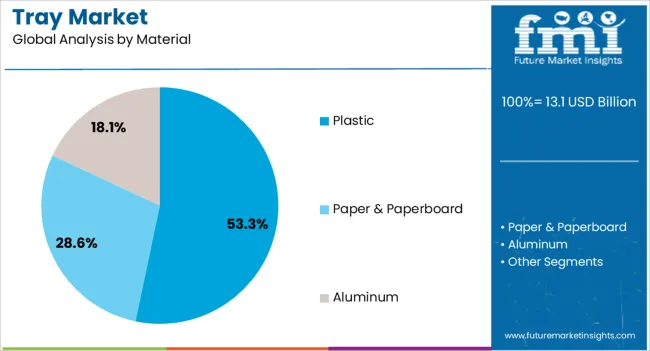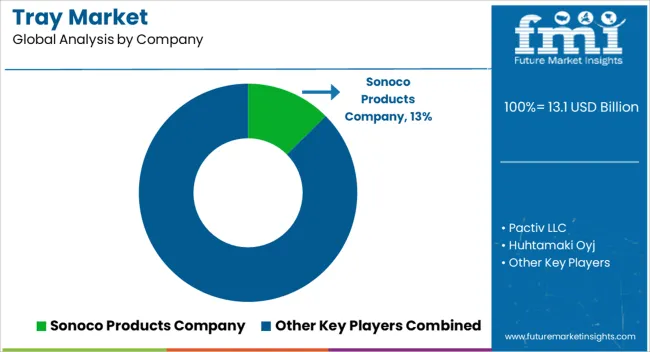The Tray Market is estimated to be valued at USD 13.1 billion in 2025 and is projected to reach USD 17.0 billion by 2035, registering a compound annual growth rate (CAGR) of 2.6% over the forecast period.
The Tray market is experiencing steady growth, driven by increasing demand across food packaging, industrial applications, and healthcare sectors. The market is being shaped by trends favoring convenience, sustainability, and high-efficiency production techniques. Rising adoption of trays for organized storage, transportation, and product presentation has amplified market penetration, particularly in fast-moving consumer goods and logistics applications.
Advancements in material engineering and tray design are enabling improved durability, weight optimization, and cost-effectiveness. The integration of automated manufacturing processes, such as thermoforming and injection molding, has enhanced production efficiency and scalability. Additionally, consumer preference for hygienic and eco-friendly packaging solutions is influencing material selection and product design.
Growing investments by manufacturers in research and development to create innovative and sustainable tray solutions are further supporting market expansion As supply chains continue to prioritize efficiency, traceability, and compliance with environmental regulations, the Tray market is poised for sustained growth, with opportunities emerging from increasing industrial automation and rising adoption in commercial and retail sectors globally.

| Metric | Value |
|---|---|
| Tray Market Estimated Value in (2025 E) | USD 13.1 billion |
| Tray Market Forecast Value in (2035 F) | USD 17.0 billion |
| Forecast CAGR (2025 to 2035) | 2.6% |
The market is segmented by Product Type, Material, and Sales Channel and region. By Product Type, the market is divided into Multiple Cavity and Single Cavity. In terms of Material, the market is classified into Plastic, Paper & Paperboard, and Aluminum. Based on Sales Channel, the market is segmented into Direct Sales, Distributors, Brick & Mortar Stores, and E-Retail. Regionally, the market is classified into North America, Latin America, Western Europe, Eastern Europe, Balkan & Baltic Countries, Russia & Belarus, Central Asia, East Asia, South Asia & Pacific, and the Middle East & Africa.

The multiple cavity product type segment is projected to hold 69.4% of the Tray market revenue in 2025, establishing it as the leading product type. Its dominance is being driven by its ability to produce several trays simultaneously, which enhances manufacturing efficiency and reduces production costs. Multiple cavity designs enable consistent quality and uniformity across large production batches, making them ideal for high-volume industries such as food processing and consumer goods.
The flexibility to customize cavity sizes and tray configurations allows manufacturers to meet varied client requirements and adapt to different packaging standards. Adoption of multiple cavity designs is also reinforced by their compatibility with automated production lines, which reduces labor dependency and improves throughput.
Continuous innovation in mold design, material compatibility, and process optimization has strengthened reliability and performance, supporting widespread use As demand for high-efficiency manufacturing and cost-effective tray production grows, the multiple cavity product type is expected to maintain its market leadership, driven by scalability and operational efficiency.

The plastic material segment is expected to account for 53.3% of the Tray market revenue in 2025, making it the leading material type. Growth in this segment is being driven by the material’s lightweight nature, durability, and versatility across applications. Plastic trays offer resistance to moisture, chemicals, and impact, making them suitable for packaging, storage, and transportation in various industries.
Advancements in polymer formulations and injection molding techniques have enhanced strength, flexibility, and recyclability, addressing both performance and sustainability concerns. The widespread availability and cost-effectiveness of plastic compared with alternative materials further reinforce adoption.
In addition, plastic trays can be produced in various shapes, sizes, and colors, supporting branding and functional requirements for commercial and industrial users As manufacturers focus on efficient, scalable, and sustainable packaging solutions, the plastic material segment is expected to continue leading the market, supported by innovations in bio-based and recyclable polymers that align with environmental regulations and consumer preferences.

The direct sales channel segment is projected to hold 36.4% of the Tray market revenue in 2025, establishing it as the leading distribution method. Its dominance is being driven by the ability to provide manufacturers and large-scale end users with personalized service, bulk order fulfillment, and faster delivery times.
Direct sales enable closer relationships between suppliers and buyers, allowing for tailored solutions, improved customer support, and better insight into market demand. This channel reduces intermediaries, lowering costs and ensuring consistent product quality and availability.
The adoption of digital platforms and e-commerce solutions has further enhanced direct sales efficiency, enabling manufacturers to manage orders, track shipments, and respond to client requirements in real time As businesses increasingly seek streamlined procurement and scalable distribution solutions, direct sales are expected to maintain a leading position, supported by growing demand for customized tray designs and reliable, high-volume supply chains that enhance operational efficiency and competitiveness.
| Historical CAGR (2020 to 2025) | 1.80% |
|---|---|
| Forecast CAGR (2025 to 2035) | 2.60% |
The tray market shows a trend of steady demand. The historical CAGR from 2020 to 2025 was at a modest 1.80%, while the projection for 2025 to 2035 is slightly improved at 2.60% CAGR. It is the result of various factors. The sustainability trend is pushing the demand for the trays made of recycled materials.
Moreover, the thriving e-commerce industry, especially in food delivery, needs creative and sturdy tray designs for safe product transportation. Technological innovations in the fresh produce industry, like sensor-equipped trays to track the freshness, further fuel the sector's growth.
Recycling Takes the Spotlight
There's a growing trend to use eco-friendly packaging, leading to more trays made of recycled stuff like used consumer products or leftover plant materials. These recycled trays are not just good for the environment by cutting down on trash, but they're also getting better and tougher thanks to new ways of manufacturing paper by companies.
The Rise of Smart Trays
The old ways of checking if food is still fresh are getting outdated. The next big thing is trays with built-in sensors that keep an eye on food quality as it happens. These smart trays pick up even small shifts in the air or temperature around the food, giving a heads-up to stores and buyers about any safety risks before things go south. This innovation by tray manufacturers could change the game in enhancing food safety and cutting down on food waste.
Packaging That Does More
Trays are no longer just pretty dishes. Now, they're getting smart and fighting off germs. Companies are testing new materials that can control temperature themselves or even have germ-killing surfaces. These high-tech dishes could help food stay fresh longer and give consumers a cleaner way to store snacks.
Anti-Tamper Trays Boost Food Safety
Customers are worried about keeping their food safe. This has led to better tray designs that show if someone's tampered with the food. One innovation is the lids that change color when opened or gadgets in the tray that keep tabs on where your food has been, from the farm all the way to your plate. With these cool updates, customers can spot tampering right away and know exactly where the food comes from.
Edible Trays to Promote Sustainability
Researchers are mixing up trays consumers can actually eat made from plants or seaweed. That's right, manufacturers are innovating the trays people can eat which are called edible containers. If this takes off, industry could say goodbye to heaps of plastic waste. Edible trays have the potential to change the game when it comes to ecofriendly food packaging.
| Segment | Estimated Market Share in 2025 |
|---|---|
| Plastic | 53.3% |
| Multiple Cavity | 69.4% |
Plastic dominates in this field with an estimated share of 53.3% in 2025. This can be attributed to its reign over others for numerous reasons. First, plastic is both affordable and durable thus economical for both customers and producers.
Secondly, plastic has the adaptability that allows it to have different sizes, shapes, and degrees of transparency which can meet various packaging requirements.
In addition, plastics possess excellent moisture barrier properties that make them perfect for use as food packaging materials or as non-food items such as consumer electronics.
Nevertheless, mounting environmental concerns about plastic waste as well as rising demand for sustainable alternatives might challenge the dominance of plastic on the market in the future.
The multi-cavity type of tray has been projected to hold a massive share equaling 69.4% come 2025 resulting from which it could be said that they are undisputed leader when it comes to product types. This domination reflects increasing efforts towards convenient packaging and optimization of space within packages.
The latest report points out new chances for businesses in the tray market in key countries. According to predictions, both China and India seem promising for tray makers looking to multiply their business. The United States, Japan, and Germany are also expected to see stable growth until 2035.
| Countries | CAGR till 2035 |
|---|---|
| United States | 1.60% |
| India | 4.70% |
| China | 3.70% |
| Japan | 1.20% |
| Germany | 1.10% |
The China tray market is accelerating with a CAGR of 3.70% until 2035. This spike is resulting from the growing middle class in the country. As people earn more money, they demand packed goods and convenient food options more than ever before.
This growing appetite for trays means that high-quality and innovative trays are a must in the packaging and presentation of such food items. Furthermore, the booming eCommerce sector in China is creating a market for strong and innovative trays tailored to ensure safe delivery of food and other items.
By 2035, the tray sector in India is likely to witness a CAGR of 4.70%. India has been experiencing this rapid growth due to having more young people who prefer convenience over anything else compared to the world’s many nations that have an aging population structure.
Additionally, increasing urbanization and busy lifestyles are driving the need for ready-to-eat meals as well as packaged snacks, which heavily rely on trays for packaging and presentation purposes only. Moreover, organized retailing/food processing would be promoted by government initiatives, leading to further expansion of the Indian tray industry.
The United States has a strong presence as a tray manufacturing hub. This alone keeps the country to continue growing steadily at a CAGR of 1.60% until 2035. The growth may not be explosive, but for such a mature market it still has high demand for excellent trays that are very innovative.
In response to sustainability pressures, eco-friendly trays made from recycled materials or with biodegradable coatings are being developed. Moreover, there is an increasing acceptance of technologically advanced US trays like smart trays with embedded sensors for detecting food freshness.
Moderate growth at a CAGR of 1.20% is likely to be attained by the Japan tray industry through 2035. Such stability demonstrates maturity in the market with an emphasis on quality. Japanese people have strict guidelines regarding the safety and presentation of their foods, hence requiring quality-oriented trays.
Besides, the space-saving factor is critical for Japan, making them opt for multi-cavity trays among other designs that allow efficient packaging and storage.
Germany's market is directed toward a steady CAGR of 1.10% by 2035. This growth may be small compared to new, fast-growing markets, but Germany provides a reliable and predictable environment for those making and selling trays.
Manufacturers who bring in new and creative types of materials or features that improve food safety, are better for the environment, or meet the unique tastes of different areas in Germany could find chances to succeed.

Top brands lead the way in the market, using their well-known names, vast delivery systems, and solid groups of customers. Brands such as Greif, Mauser Group, Schoeller Allibert, and Schutz are big players in the metal tray area. Meanwhile, Pactiv and Huhtamaki stand out in the plastic tray sector. These large companies invested a lot of time creating new tray styles and features to keep being the best.
Smaller local companies also own a good chunk of the market in their areas. These businesses meet unique local demands and follow local rules, giving them an advantage close to home. For example, Nalgene is big in North America, and Auriplast is known in Asia. They're good at knowing what their nearby customers want and changing their products to match.
Plastic was usually the go-to material, but now people are worried about the planet, opening doors for new companies. These special businesses are getting involved by offering different materials.
Using paper trays made from recycled stuff or coatings that break down easily is starting to take away business. Also, smart packaging options like big, flexible bags for transporting a lot of stuff (FIBCs) are competing because they can be cheaper and better for certain uses.
Recent Developments in the Tray Industry:
The global tray market is estimated to be valued at USD 13.1 billion in 2025.
The market size for the tray market is projected to reach USD 17.0 billion by 2035.
The tray market is expected to grow at a 2.6% CAGR between 2025 and 2035.
The key product types in tray market are multiple cavity and single cavity.
In terms of material, plastic segment to command 53.3% share in the tray market in 2025.






Full Research Suite comprises of:
Market outlook & trends analysis
Interviews & case studies
Strategic recommendations
Vendor profiles & capabilities analysis
5-year forecasts
8 regions and 60+ country-level data splits
Market segment data splits
12 months of continuous data updates
DELIVERED AS:
PDF EXCEL ONLINE
Tray Sealing Machines Market Size and Share Forecast Outlook 2025 to 2035
Tray Dispensers Market Size and Share Forecast Outlook 2025 to 2035
Tray and Sleeve Packing Machines Market Size and Share Forecast Outlook 2025 to 2035
Tray Former Machines Market Size and Share Forecast Outlook 2025 to 2035
Tray Sealer Machines Market Size and Share Forecast Outlook 2025 to 2035
Industry Share & Competitive Positioning in Tray Sealer Machines
Market Share Distribution Among Tray Former Machines Manufacturers
Tray Liners Market
Tray Packing Machine Market
Tray Loader Market
ESD Trays Market Size and Share Forecast Outlook 2025 to 2035
Lab Trays Market Size and Share Forecast Outlook 2025 to 2035
Food Tray Market Size and Share Forecast Outlook 2025 to 2035
Meat Trays Market Analysis - Size and Share Forecast Outlook 2025 to 2035
Meal Tray Sealing Machines Market Size and Share Forecast Outlook 2025 to 2035
Key Companies & Market Share in the Food Trays Sector
CPET Trays Market
Tilt tray sorter Market
Cable Tray Market Size and Share Forecast Outlook 2025 to 2035
Sieve Trays Market Size and Share Forecast Outlook 2025 to 2035

Thank you!
You will receive an email from our Business Development Manager. Please be sure to check your SPAM/JUNK folder too.
Chat With
MaRIA